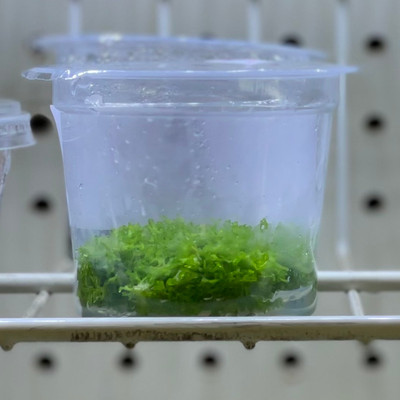Riccia Fluitans: Exploring the Lush World of Floating Crystalwort
Posted by Max Gandara on on 18th Apr 2024
Riccia Fluitans: Exploring the Lush World of Floating Crystalwort
Riccia Fluitans, commonly known as Floating Crystalwort or simply Riccia, is a fascinating aquatic plant renowned for its buoyant nature, intricate morphology, and versatility in aquascaping. Originating from regions of Asia, Europe, and Africa, this species has captivated aquarists and planted tank enthusiasts with its ability to form dense floating mats and contribute to the aesthetic appeal of aquariums and paludariums. In this detailed article, we will delve into the taxonomy, morphology, cultivation, propagation, and creative applications of Riccia Fluitans.
Taxonomy and Morphology: Riccia Fluitans belongs to the Ricciaceae family within the liverwort division of plants. Despite its common name "Floating Crystalwort," Riccia Fluitans is not a true moss but rather a liverwort, characterized by its flattened thallus structure and lack of true roots, stems, or leaves. The thallus of Riccia Fluitans consists of a thin, ribbon-like structure with dichotomously branched branches, creating a delicate and intricate appearance reminiscent of floating ferns.
Natural Habitat: Native to regions of Asia, Europe, Africa, and beyond, Riccia Fluitans inhabits a variety of aquatic habitats, including ponds, lakes, streams, and marshy areas. In its natural habitat, this species typically grows attached to submerged surfaces, such as rocks, driftwood, or aquatic vegetation, forming floating mats that provide shelter and spawning sites for aquatic organisms. Its ability to float on the water's surface allows Riccia Fluitans to access sunlight and nutrients while absorbing carbon dioxide and releasing oxygen through its thallus.
Cultivation Requirements: Cultivating Riccia Fluitans in aquariums requires attention to specific environmental parameters to ensure optimal growth and health. Moderate to high lighting is recommended to promote photosynthesis and prevent the formation of dense, compact mats that can shade lower portions of the plant. Additionally, stable water parameters, including temperature (22°C to 28°C or 72°F to 82°F), pH (6.0 to 7.5), and hardness, support the well-being of Riccia Fluitans.
Substrate: Riccia Fluitans does not require a substrate for growth but can be anchored to surfaces such as rocks, driftwood, or mesh mats using fishing line or mesh. Alternatively, it can be left to float freely on the water's surface, where it will form dense mats over time. In aquariums with substrate, Riccia Fluitans may occasionally attach itself to the substrate through its rhizoids but will primarily grow as a floating plant.
Propagation: Propagation of Riccia Fluitans is straightforward and can be achieved through fragmentation or division of the thallus. Simply separate portions of the thallus and anchor them to desired surfaces using fishing line or mesh. Over time, the fragmented portions will establish new growth and expand to form dense floating mats. Regular pruning helps control growth and prevent overcrowding, allowing light to penetrate to lower portions of the plant.
Maintenance and Care: Regular maintenance is essential for sustaining the health and appearance of Riccia Fluitans in aquariums. Pruning helps control growth and prevent the formation of dense mats that can shade lower portions of the plant. Additionally, removing debris and detritus from the water's surface helps maintain water quality and prevents nutrient imbalances.
Aquascaping Applications: Riccia Fluitans' unique floating growth habit and delicate appearance make it an excellent choice for various aquascaping layouts. Whether used as a floating carpeting plant or as a midground accent, this species adds texture, depth, and visual interest to aquatic landscapes. Its ability to form dense floating mats provides shelter and spawning sites for small fish and invertebrates while enhancing the aesthetic appeal of the aquarium. When combined with other aquatic plants and decorative elements, such as rocks, driftwood, and stem species, Riccia Fluitans contributes to dynamic and visually appealing aquascapes, enhancing their overall aesthetic appeal.
Riccia Fluitans stands as a testament to nature's beauty and adaptability, captivating aquarists with its intricate morphology and versatile growth habits. By understanding its requirements and implementing proper care practices, hobbyists can enjoy the splendor of Riccia Fluitans in their aquariums, creating immersive and captivating underwater landscapes for all to admire.

